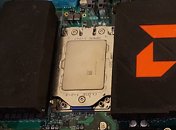- Joined
- Oct 9, 2007
- Messages
- 47,687 (7.42/day)
- Location
- Dublin, Ireland
| System Name | RBMK-1000 |
|---|---|
| Processor | AMD Ryzen 7 5700G |
| Motherboard | Gigabyte B550 AORUS Elite V2 |
| Cooling | DeepCool Gammax L240 V2 |
| Memory | 2x 16GB DDR4-3200 |
| Video Card(s) | Galax RTX 4070 Ti EX |
| Storage | Samsung 990 1TB |
| Display(s) | BenQ 1440p 60 Hz 27-inch |
| Case | Corsair Carbide 100R |
| Audio Device(s) | ASUS SupremeFX S1220A |
| Power Supply | Cooler Master MWE Gold 650W |
| Mouse | ASUS ROG Strix Impact |
| Keyboard | Gamdias Hermes E2 |
| Software | Windows 11 Pro |
AMD Ryzen 9 "Threadripper" series 12-core, 14-core, and 16-core client desktop processors, which will form the company's next-generation high-end desktop (HEDT) lineup, which goes against Intel Core i9 "Skylake-X" series, could come in a brand new socket. This shouldn't come as a surprise because the chips have higher electrical requirements, besides double the I/O of socket AM4 Ryzen processors, such as a 44-lane PCIe gen 3.0 root complex, quad-channel DDR4 memory interface, and more. This socket, according to a "HotHardware" report, is an LGA (land-grid array) with 4,094 pins.
The new LGA-4094 socket, so-called SP3r2, will be slightly scaled up from the SP3 socket AMD has been selling enterprise Opteron-brand multi-socket CPUs on (pictured below). The consumer version of this socket could feature a more user-friendly retention mechanism that shouldn't require a screwdriver to fasten. Motherboards based on this distinctively rectangular socket will feature up to eight DDR4 DIMM slots to hold quad-channel DDR4 memory, and over four PCI-Express 3.0 x16 slots, with support for 3-way and 4-way multi-GPU solutions. The motherboards will also feature copious amounts of onboard devices, M.2 slots, and other storage connectivity. Since "Threadripper" is rumored to be a multi-chip module of two 14 nm "Summit Ridge" dies linked together on-package with with an Infinity Fabric interconnect, only one of the two dies links to the motherboard chipset (AMD X399 chipset), while all the PCIe lanes of the second die (including those which would make up the chipset bus) are freed up.

View at TechPowerUp Main Site
The new LGA-4094 socket, so-called SP3r2, will be slightly scaled up from the SP3 socket AMD has been selling enterprise Opteron-brand multi-socket CPUs on (pictured below). The consumer version of this socket could feature a more user-friendly retention mechanism that shouldn't require a screwdriver to fasten. Motherboards based on this distinctively rectangular socket will feature up to eight DDR4 DIMM slots to hold quad-channel DDR4 memory, and over four PCI-Express 3.0 x16 slots, with support for 3-way and 4-way multi-GPU solutions. The motherboards will also feature copious amounts of onboard devices, M.2 slots, and other storage connectivity. Since "Threadripper" is rumored to be a multi-chip module of two 14 nm "Summit Ridge" dies linked together on-package with with an Infinity Fabric interconnect, only one of the two dies links to the motherboard chipset (AMD X399 chipset), while all the PCIe lanes of the second die (including those which would make up the chipset bus) are freed up.

View at TechPowerUp Main Site







